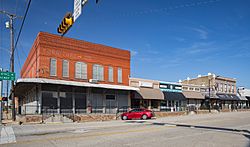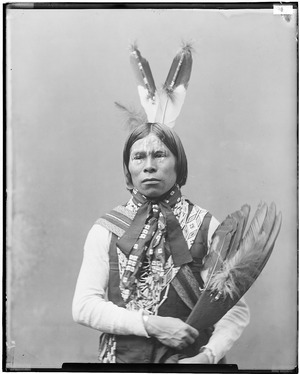Midlothian, Texas facts for kids
Quick facts for kids
Midlothian, Texas
|
||
|---|---|---|
 |
||
|
||
| Motto(s):
"DFW's Southern Star"
|
||
| Country | United States | |
| State | ||
| County | Ellis | |
| Government | ||
| • Type | Council-Manager | |
| Area | ||
| • Total | 64.23 sq mi (166.34 km2) | |
| • Land | 63.50 sq mi (164.47 km2) | |
| • Water | 0.73 sq mi (1.88 km2) | |
| Elevation | 755 ft (230 m) | |
| Population
(2010)
|
||
| • Total | 18,037 | |
| • Estimate
(2019)
|
33,532 | |
| • Density | 528.06/sq mi (203.88/km2) | |
| Time zone | UTC−6 (Central (CST)) | |
| • Summer (DST) | UTC−5 (CDT) | |
| ZIP Code |
76065
|
|
| Area code(s) | 972 | |
| FIPS code | 48-48096 | |
| GNIS feature ID | 1341552 | |
Midlothian is a city in northwest Ellis County, Texas, United States. The city is 25 miles (40 km) southwest of Dallas. It is the hub for the cement industry in North Texas, as it is the home to three separate cement production facilities, as well as a steel mill. The population of Midlothian grew by 121% between 2000 and 2010, to a population of 18,037.
Contents
Geography
Midlothian is located in northwestern Ellis County at 32°28′49″N 96°59′22″W / 32.48028°N 96.98944°W (32.480169, -96.989350). Adjacent cities are Cedar Hill to the north, Grand Prairie to the northwest, Venus to the southwest, Waxahachie to the southeast, and Ovilla to the northeast.
According to the United States Census Bureau, in 2010 the city had a total area of 50.4 square miles (130.5 km2), of which 49.8 square miles (128.9 km2) was land and 0.66 square miles (1.7 km2), or 1.28%, was water. Midlothian's extraterritorial jurisdiction includes another 33 square miles (85 km2).
History
In the early 1800s, settlements began to take place in the area that would one day become Ellis County; however, full colonization of this area was slow until 1843, when Sam Houston finalized peace treaties between several of the indigenous inhabitants of the region and the Republic of Texas. The earliest inhabitants of this area were the Tonkawa people, but other tribes also hunted in this area including the Anadarko people, Bidai, Kickapoo, and the Waco.
The future Ellis County area of the young Republic of Texas was known as the Peters Colony, named for a Louisville, Kentucky-based land grant company consisting of English and American investors. The young Republic empresario grant program encouraged settlements in North Texas in 1841. The few settlers who lived in this region trapped animals and sold their pelts, and would also trade goods with the natives. The majority of Ellis County's original settlers came from the southern half of the United States. They arrived with their cultural and educational traditions, their methods of farming and care for farm animals and for a few, their slaves.
Among the earliest settlers, the area that would later become Midlothian included the families of William Alden Hawkins and Larkin Newton, who moved to the area in 1848. For Hawkins to claim his 640 acres (260 ha) of land from the Peters Colony group, he was required to build a house on the property he chose along the mouth of Waxahachie Creek before July 1, 1848. The structure was built before the required deadline, and the land near the present day Hawkins Spring went to the Hawkins family. For Larkin Newton, who moved his wife Mary and their eight children from Missouri, the same requirement was given. Larkin met the due date and became owner of his 640-acre claim.
Ellis County was officially established by the Texas legislature on December 20, 1849, on a bill sponsored by General Edward H. Tarrant, a popular Texas Ranger and Indian gunfighter during this period. Organized in February 1850, the county was carved out of Navarro County and likely named for Richard Ellis, the president of the Republic of Texas.
In 1883 the name "Midlothian" was accepted by the local population. According to local legend, the area was named Midlothian when the Chicago, Texas, and Mexican Central railroads, which would eventually connect Dallas and Cleburne, arrived in the area and a homesick Scottish train engineer stated that the local countryside reminded him of his homeland in Scotland, and the location served as the midpoint between Dallas and Cleburne, and between Ennis and Fort Worth. With the coming of the railroad, Midlothian grew and was incorporated in April 1888. Midlothian was one of Scotland's historic counties and is currently a subdivisional council area.
Demographics
| Historical population | |||
|---|---|---|---|
| Census | Pop. | %± | |
| 1890 | 297 | — | |
| 1900 | 832 | 180.1% | |
| 1910 | 868 | 4.3% | |
| 1920 | 1,298 | 49.5% | |
| 1930 | 1,168 | −10.0% | |
| 1940 | 1,027 | −12.1% | |
| 1950 | 1,177 | 14.6% | |
| 1960 | 1,521 | 29.2% | |
| 1970 | 2,322 | 52.7% | |
| 1980 | 3,219 | 38.6% | |
| 1990 | 5,141 | 59.7% | |
| 2000 | 7,480 | 45.5% | |
| 2010 | 18,037 | 141.1% | |
| 2019 (est.) | 33,532 | 85.9% | |
| U.S. Decennial Census | |||
As of the 2010 census, the population density was 362.5 people per square mile (76.6/km2), with a total population of 18,037 people. The 6,138 housing units averaged 74.0 per square mile (28.6/km2). The racial makeup of the city was 88.5% White, 3.6% African American, 0.4% Native American, 0.8% Asian, 0.1% Pacific Islander, 4.2% from other races, and 2.4% from two or more races. Hispanics or Latinos of any race were 15.2% of the population.
Of the 4,963 households, 46.0% had children under the age of 18 living with them, 63.1% were married couples living together, 12.7% had a female householder with no husband present, and 19.1% were not families. About 15.5% of all households were made up of individuals, and 4.7% had someone living alone who was 65 years of age or older. The average household size was 2.94 and the average family size was 3.26.
In the city, the population was distributed as 34.1% under the age of 19, 5.2% from 20 to 24, 30.1% from 25 to 44, 22.7% from 45 to 64, and 7.7% who were 65 years of age or older. The median age was 32.1 years. For every 100 females, there were 96.6 males.
As of the 2000 census, the median income for a household in the city was $49,464, and for a family was $55,055. Males had a median income of $37,151 versus $27,209 for females. The per capita income for the city was $19,329. About 4.4% of families and 6.3% of the population were below the poverty line, including 8.2% of those under age 18 and 8.0% of those age 65 or over.
Transportation
Midlothian is located at the junction of U.S. Highway 67 and U.S. Highway 287. The city's location provides easy access to an important ground transportation network consisting of interstate highways, U.S. highways, and state highways that connects Dallas, Fort Worth, the rest of the Metroplex, and the state.
In May 2015, Padera Lake, located three miles northwest of Midlothian, was full from torrential rains. Water overflowing and cracks in an earthen dam gave rise to concerns that failure was imminent. If the dam failed, U.S. Route 287 could have been flooded with up to 15 ft of water, and some severe flooding in the north-flowing direction towards Joe Pool Lake. Relief efforts included pumping water from behind the dam, and disaster was averted.
MidWay Regional Airport
Located 3 miles (5 km) east of Midlothian is MidWay Regional Airport (JWY). Jointly operated by the cities of Midlothian and Waxahachie, MidWay Regional Airport is a 320-acre (130 ha) corporate and general-aviation airport. It is a full-service fixed-base operator offering maintenance, repair, rental, sales, servicing, flight planning, computerized weather, UNICOM, RCO, and AWOS. The airport opened in October 1992 to serve a rapidly growing area. An expansion project completed in January 2012 included a major terminal renovation.
Climate
The climate in this area is characterized by hot, humid summers and generally mild to cool winters. According to the Köppen Climate Classification system, Midlothian has a humid subtropical climate, abbreviated "Cfa" on climate maps.
Economy
Prior to 1929 and the Great Depression, a number of businesses flourished in the city. The two largest business enterprises centered around cotton and cattle-raising. The region was transformed in later years by the arrival of the cement industry. Midlothian became a prime area for cement quarrying due to the Austin Chalk Escarpment, a unique geological formation that runs north–south through the city. Three of the top-10 largest cement factories in the United States operate in the city: TXI (formerly Texas Industries), Holcim, and Ash Grove. Gerdau Ameristeel, formerly Chaparral Steel, a large steel factory, is adjacent to TXI's cement plant.
A large industrial park, Railport, is located along U.S. 67 on the southwestern side of the city. Railport is home to several distribution facilities including Target and QuikTrip.
The north side of the city is host to MidTexas International Center's Auto Park, a large automobile distribution and processing center; and Texas Central Business Lines, a rail transload facility.
Top employers
According to Midlothian's 2010 Comprehensive Annual Financial Report, the top employers in the city are:
| # | Employer | # of Employees |
|---|---|---|
| 1 | Midlothian Independent School District | 933 |
| 2 | Gerdau Ameristeel | 832 |
| 3 | Target | 600 |
| 4 | Walmart | 400 |
| 5 | Toys "R" Us | 300 |
| 6 | City of Midlothian | 197 |
| 7 | TXI | 174 |
| 8 | Holcim | 170 |
| 9 | Navarro College | 80 |
| 10 | MidTexas International Center | 75 |
| 11 | Big Hodge | 15 |
Education
Primary and secondary education
Primary and secondary education for the community is provided by the Midlothian Independent School District (MISD), which encompasses an area around 112 square miles (290 km2). MISD conducts programs for kindergarten through grade 12 and employs roughly 850 employees. MISD has nine school campuses (six are elementary schools with grades K–5) with 461 teachers and an enrollment of 7,564 for the 2012–2013 school year. The student-to-teacher ratio is 16 to 1.
MISD students have historically excelled in a number of extracurricular activities. At Midlothian High School, called the "Panthers", students have been awarded numerous times in agricultural problem-solvers competitions, and high-quality music organizations. The Midlothian High School baseball, soccer, and softball teams are often seen in the 5A playoff bracket. A $14,000,000 multipurpose athletic stadium was constructed in 2006. The second high school is Midlothian Heritage High School, as they compete in 4A for sports and extracurricular activities. They will be moved up to 5A for the 2022-2023 school year.
Midlothian had two National Merit finalists in 2006, 2007, and 2008.
Higher education
Higher education opportunities are also readily available in Midlothian. On April 25, 2012, the Texas Higher Education Coordinating Board approved the establishment of a multi-institutional teaching center (MITC) in Midlothian known as the Midlothian Higher Education Center (MHEC). As one of only nine MITCs in Texas, the MHEC is a partnership consisting of Navarro College-Midlothian, Tarleton State University, Texas A&M University-Commerce, and University of North Texas-Dallas. The collaboration between the four institutions provides area students the ability to complete baccalaureate and graduate degree programs at Navarro College's Midlothian campus.
Images for kids
See also
 In Spanish: Midlothian (Texas) para niños
In Spanish: Midlothian (Texas) para niños






